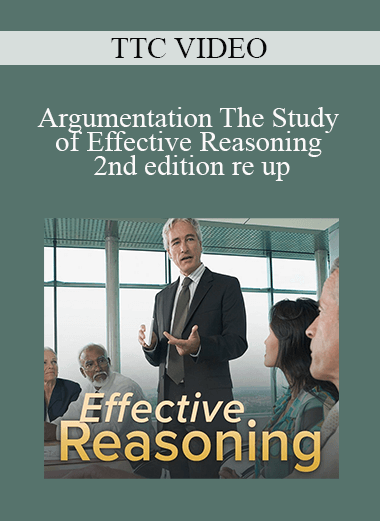What is effective argumentation? How does it work? Abraham Lincoln, Franklin D. Roosevelt, and other great figures were masters of the craft. So how can you reason through your position and make the best possible case for it with the same skill and ease as the experts? Argumentation: The Study of Effective Reasoning, 2nd Edition is a rigorous introduction to the formal study of argumentation—communication that seeks to persuade others through reasoned judgment.
In 24 lectures you learn the building blocks of an argument, the different categories of argument and the issues that are at stake in each, the kinds of evidence that serve as proof in an argument, and many other aspects of argumentation and reasoning, illustrated with examples from some of the most famous speeches, debates, and controversies in American history.
What You Learn
Award-winning Professor David Zarefsky of Northwestern University has five goals for this course:
- You will learn how to recognize arguments; how to find them in conversations, newspaper editorials, speeches, in controversies of any kind; and how to know them when you encounter them.
- You will become aware of how arguing reflects choice, broadening your understanding of the choices that arguers can make and that you can make when you build and construct an argument.
- You will learn how to evaluate various types of arguments. In the process, you’ll learn the standards that should govern your assessment of these qualities.
- In attempting all of these tasks you will examine examples of a variety of historical and contemporary arguments, shedding light on some significant controversies by looking at them from the perspective of argument.
- Having become familiar with argumentation theories, you should be able to improve your ability both as an analyst and as a maker of arguments.
Argumentation starts with four lectures that review the intellectual and historical backgrounds of argumentation. Then in Lectures 5 through 11 you explore the strategies and tactics of argument construction, attack, and defense. Lectures 12 through 18 consider the components of argument in greater detail and examine how they work. Next, Lectures 19 and 20 focus on the appraisal of arguments. Finally, in Lectures 21 through 24, you investigate how argumentation functions in society, covering such topics as argumentation in specialized fields and the different ways that arguments can end.
Argumentation in Action
Professor Zarefsky infuses Argumentation with rich historical examples to illustrate the principles of argumentation in action. For example, in 2003, U.S. Secretary of State Colin Powell gave a dramatic speech before the U.N. Security Council, seeking approval for the use of military force against Iraq. Dr. Zarefsky uses this speech to explore how arguments employ complex structures. Secretary Powell’s address used a combination of parallel and convergent structures. Through careful analysis, you’ll learn how these structures work logically and why supporters of President Bush’s Iraq policy treated the arguments as purely parallel, while opponents treated them as convergent.
Why should you practice this kind of argument analysis? “It enables you to understand what’s going on in the argument,” says Professor Zarefsky. “Few of us are ever going to have the opportunity to address the U.N. Security Council, but if you do this with a letter to the editor, or an editorial in the local newspaper, or in a conversation that you have in your family, the same process works just as well, and you can get some real insight into the nature of the arguments.”
Principles behind Historic Speeches
More examples of important principles at work in historic speeches include
- The Lincoln-Douglas Debates of 1858: The dueling speeches of U.S. Senate candidates Abraham Lincoln and Stephen A. Douglas illustrate the principle that argumentation takes place with a particular audience in mind—in this case, the swing voters of central Illinois. You also learn that all argument involves risk, and that Lincoln and Douglas each sacrificed strategic advantages in meeting to debate.
- Lyndon Johnson’s 1965 Voting Rights Message: President Johnson’s historic address to a joint session of Congress was a policy-oriented speech that focused masterfully on the relevant topoi—the traditional categories of issues that arise in dealing with a controversy. You learn why it was named one of the top 10 American speeches of the 20th century by a national survey of communications scholars.
- The Kennedy-Nixon Debates of 1960: John F. Kennedy’s reply to a journalist’s question during the third presidential debate with Richard Nixon illustrates the application of the “mini-max” principle—the minimum effort and risk yielding the maximum gain. You see why Nixon’s rebuttal does not reflect the best strategic choices in meeting Kennedy’s arguments.
- Abraham Lincoln’s House-Divided Speech: Lincoln’s speech accepting nomination to run for the U.S. Senate against Stephen Douglas demonstrates a classic use of figures of speech. Lincoln employs the analogy of workmen building a frame house to connect prominent politicians of the day with a plot to legalize slavery throughout the United States. He can’t prove it directly, but by using a clever figurative analogy he makes a convincing case that the plot is inexorably unfolding.
- Franklin D. Roosevelt’s December 8, 1941, War Message: Roosevelt’s speech to Congress on the day after the Pearl Harbor attack is a vivid model of a type of argument called the warrant from example. A warrant is an authorization to make an inference from evidence to claim, and Roosevelt cites a litany of examples of Japanese aggression to establish their intent for general war.
- Martin Luther King, Jr.’s “I Have A Dream” Speech: You learn how this celebrated speech illustrates a sign argument, in which Dr. King juxtaposes intolerable conditions for African Americans with a Scriptural allusion to the onrushing “mighty stream” of justice. He infers that one phenomenon predicts, or is a sign for, the other.
A Teacher with Passion, Insight, and Humor
These are just some of the creative ways that Professor Zarefsky explains a subject that is inherently fascinating, though often technical and demanding. Rarely has it been taught with the passion, insight, and humor that Professor Zarefsky displays.
For instance, in discussing the concept of “stasis,” he shows how a simple accusation of theft offers a variety of responses that will determine exactly what is at issue and therefore what needs to be settled. That point of dispute is called the stasis. The claim, “You stole my car,” could be countered with, “No, I never had your car,” asserting that the act never took place. This is called “stasis of conjecture”. By contrast, the reply, “I only borrowed your car,” signals an argument over how to characterize the act and is called “stasis of definition.” “I needed your car for an emergency” cites urgent circumstances and is called “stasis of quality.” And a refusal to discuss the matter at this particular time and place with the response, “If you’ve got a case, then take me to court,” indicates that another forum is more appropriate and is called “stasis of place.” Determining stasis is crucial to understanding the issues at play in any argument.
Additional technical aspects of argumentation that you study include the basic structure of arguments (claim, evidence, inference, and warrant); the patterns of complex arguments (multiple, coordinative, and subordinative); the six types of inductive inference (example, analogy, sign, cause, commonplaces, and form); and such strategic issues as patterns of attack and defense, choices of language and style, and fallacies to avoid, including the surprising insight that the exact same pattern of inference can sometimes be fallacious and sometimes valid, depending on circumstances.
Sound Argumentation: Antidote to Destructive Behaviors
Throughout Argumentation, Professor Zarefsky never loses sight of the purpose of sound argumentation. “Argumentation legitimizes freedom of speech and makes it work to a constructive purpose,” thereby preventing a debasing trend in which bad arguments drive out good.
Professor Zarefsky notes that a June 2005 op-ed piece in The New York Times suggested that argumentation may be a lost art. The article pointed out that people increasingly interact only with those who already agree with them; that differences of opinion are treated as unbridgeable; and that attempts to persuade are cloaked in deception. The result is fewer opportunities for compromise, deliberation, and mutual understanding. “Understanding and practicing argumentation is the antidote to these destructive behaviors,” says Professor Zarefsky. The crucial difference that makes arguments productive, instead of futile, is an appreciation for the principles that underlie this common, vital human activity.
Get Download TTC VIDEO – Argumentation The Study of Effective Reasoning 2nd edition re up at coursesblock.com today!
Delivery Method
– After your purchase, you’ll see a View your orders link which goes to the Downloads page. Here, you can download all the files associated with your order.
– Downloads are available once your payment is confirmed, we’ll also send you a download notification email separate from any transaction notification emails you receive from coursesblock.com
– Since it is a digital copy, our suggestion is to download and save it to your hard drive. In case the link is broken for any reason, please contact us and we will resend the new download link.
– If you cannot find the download link, please don’t worry about that. We will update and notify you as soon as possible at 8:00 AM – 8:00 PM (UTC 8).
Thank You For Shopping With Us!







